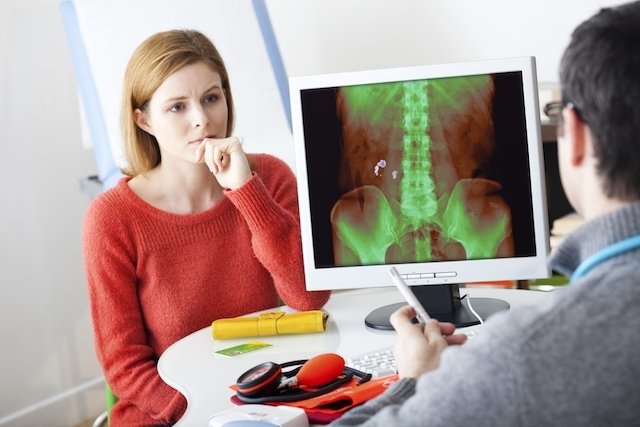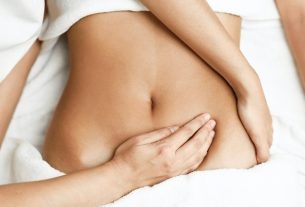A renal colic crisis is an episode of intense and acute pain in the lower and side of the back, which can also reach the front of the abdomen, making day-to-day activities difficult. In some cases, renal colic may be accompanied by burning urination and the presence of blood in the urine.
Renal colic is mainly caused by the presence of kidney stones, which cause inflammation and obstruction of the flow of urine in the urinary tract. However, it can also be caused by an infection in the kidneys, the presence of cysts or a tumor in the region.
Watch the following video and understand more about renal colic:
Renal colic symptoms
The main symptom of renal colic is intense pain in the back and side of the back, the intensity of which can vary throughout the day, making movement and daily activities difficult.
Furthermore, the pain from renal colic can radiate to the groin and can also be felt in the abdominal or genitourinary region, which may vary according to the cause of the colic. See how to identify renal colic.
Therefore, in the presence of symptoms that may indicate renal colic, it is important to consult a nephrologist or urologist so that the cause of the pain can be identified and the most appropriate treatment can be indicated.
Main causes
The main causes of renal colic are:
- Presence of kidney stones;
- Kidney infection, called pyelonephritis;
- Presence of cyst in the kidneys;
- Swelling of the kidney, called hydronephrosis;
- Kidney tumors.
To identify the cause of renal colic, the doctor may recommend imaging tests to evaluate the kidneys, such as magnetic resonance imaging, computed tomography and/or abdominal ultrasound. Learn about other causes of renal colic.
Which doctor to consult
The best doctor to diagnose and help treat a renal colic crisis is a nephrologist, as he is a specialist in kidney problems. However, the urologist can also help alleviate symptoms, referring you to a nephrologist if deemed necessary.
What to do to relieve colic
In case of renal colic, it is important that the nephrologist or urologist is consulted so that the best treatment can be indicated to alleviate the pain, to identify the cause and to prevent new attacks of renal colic.
1. Treatment with medicine
To alleviate the intense pain of kidney crisis, it is important to use oral medications or medications applied directly to the vein, which can be more effective and cause faster relief:
- Anti-inflammatoriessuch as Diclofenac, Ketoprofen or Ibuprofen: these are usually the first option, as in addition to relieving pain, they can reduce the inflammatory process that causes swelling and worsens the crisis;
- Conventional analgesicssuch as Dipyrone and Paracetamol: they are important for relieving pain;
- Opioid pain relieverssuch as Codeine, Tramadol and Morphine: they are important to reduce pain, which needs to be more powerful as the pain becomes more intense;
- Antispasmodicssuch as Hyoscine or scopolamine, known as Buscopan: help reduce spasms in the kidneys, bladder and urinary tract, which occur because the stone can occlude the flow of urine, and this is an important cause of pain;
Other types of medication may also be recommended by the doctor, such as antiemetics, such as Bromopride, Metoclopramide or Dramin, for example, to relieve nausea and vomiting.
Furthermore, after the crisis, the doctor may also recommend the use of medicines to help eliminate the stone more easily and prevent new crises, such as tamsulosin, for example.
2. Drink plenty of water
It is recommended that people with renal colic drink between 2 and 3 liters of water per day, distributed in small doses throughout the day. Hydration is essential both during the treatment of the crisis and afterwards, to facilitate the elimination of the stone, as it stimulates the formation of urine and the functioning of the kidneys, in addition to preventing the emergence of new stones in the future.
3. Avoid foods high in oxalate
As the main cause of renal colic is the presence of kidney stones, it is essential to pay attention to your eating habits, as consuming foods rich in oxalate can increase the risk of stone formation. Therefore, it is recommended to avoid the consumption of spinach, cocoa, chocolate, beetroot, peanuts, nuts, shellfish and seafood, soft drinks, coffee and some teas, such as black, mate or green tea.
It is also recommended to avoid excess vitamin C and too much protein, not consuming more than 100g per day, in addition to it being important to eliminate salt from the diet. Check out what the diet should be like for people with kidney stones.
4. Home remedies
Home remedies for renal colic must be recommended by the doctor with the aim of complementing the treatment, and the consumption of stonebreaker tea may be recommended, which prevents the aggregation of crystals, preventing the formation of large stones, which is the main cause of renal colic.
Furthermore, during the crisis, a compress with a hot water bottle can be applied to the painful area, which helps to dilate the urinary canals for the passage of the stone, in addition to promoting pain and discomfort relief.
5. Surgery
Surgery to relieve renal colic is only indicated in cases where the pain is intense, persistent and debilitating and does not improve even after the use of medication, when urinary stones are larger than 0.8 cm or when they are small but are causing obstruction of the urinary tract and compromising kidney function, and when there is suspicion of associated infection. Learn more about kidney stone surgery.




